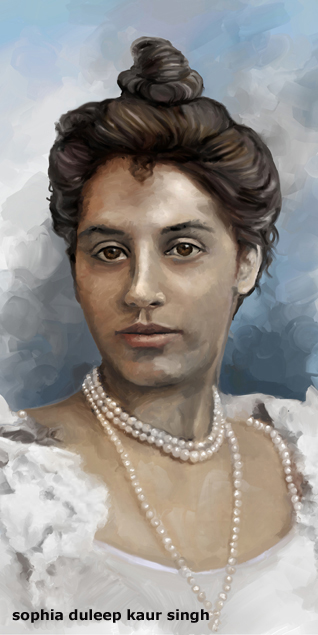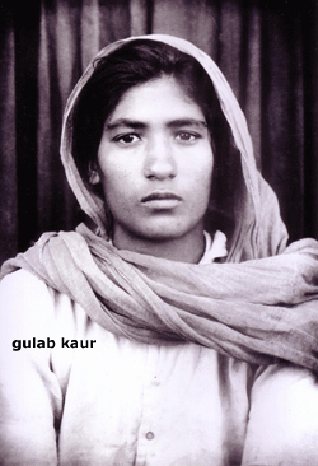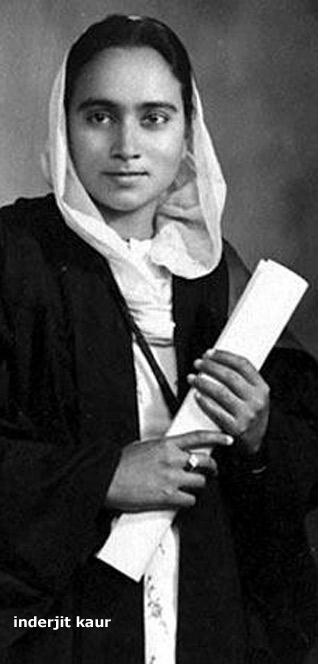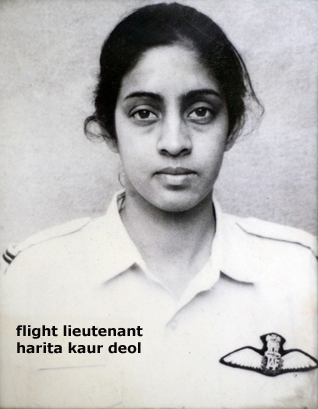Our Heroes
Trailblazers
LAKHPREET KAUR
Oftentimes, women’s contributions are overlooked because, for the most part, it is men who write history.
On the Indian subcontinent, women of the Sikh faith have fought, ruled, taught and served for centuries. They have managed organizations, guided communities and led revolts. These accomplishments are admirable in their own right, and they are even more impressive when viewed in the context of the intense patriarchy and cultural misogyny against which these women were working.
We know about some women, but there are others whose stories have been lost to time.
Here are 10 badass Sikh women of history who have shaped our world and whose legacies inspire us today. Armed with the Sikh belief in social justice and gender equality, these women paved the way for a more just and compassionate world.
(Note: Many of these women have the last name 'Kaur'. They are not necessarily related. Women of the Sikh faith share the same last name 'Kaur' -- nowadays, a middle name to some -- as a way to indicate equality and sisterhood. At the end of the 17th century, the 10th Sikh Guru asked all Sikhs to adopt a collective name, hitherto reserved for royal families, to signify the inherent equality and nobility of every individual … with women enjoying an identity independent of men: ‘Kaur’ for women and ‘Singh’ for men. This challenged the pervasive Hindu caste system in which traditional family last names were used to signify one’s social status and undermined the patriarchal practices of taking the husband’s name.)
I THE FREEDOM FIGHTER
GULAB KAUR (1890–1941)
Coming from a poor family, Gulab Kaur and her husband, Man Singh, sought a better future. So, from Punjab, they went to Manila, Philippines, with the ultimate aim of migrating to America.
In Manila, Gulab Kaur heard lectures by the Ghadar Party, an organization founded by Sikh-Punjabis abroad with the aim to liberate the subcontinent from British Rule. She was inspired to join the movement and, with a press pass in hand and disguised as a journalist, she distributed arms to Ghadar Party members.
Gulab Kaur also encouraged others to join the Ghadar Party by distributing independence literature and delivering inspiring speeches to Indian passengers of ships. She was ultimately sentenced to two years in prison in Lahore, Punjab (then in British India, now in Pakistan) for seditious acts.
II THE BISHOP-MAYOR
BIBI BHAG BHARI (late 1400s – early 1500s)
Bibi Bhag Bhari was one of the first to occupy a seat in the Sikh administrative system (Manji -- bishopric) of Punjab. Under the aegis of the Sikh Gurus, the Manji system was tasked with keeping the Sikh community across Punjab and the subcontinent strong and cohesive.
Bibi Bhag Bhari was appointed to the Manji of Kashmir and ultimately chosen for this role because Guru Amar Das (the Third Master) felt she was fully conversant with the doctrines of the Sikh faith. Ultimately, she acted as a spiritual and political leader, as she was responsible for the economic, religious, and social affairs of the Sikhs of Kashmir.
III AIR FORCE PIONEER
HARITA KAUR DEOL (1972–1996)
Hailing from Chandigarh, Punjab, Harita Kaur Deol became one of first seven women cadets inducted into the Air Force as Short Service Commission (SSC) officers in 1993. She then became the first woman pilot to fly solo for the Indian Air Force. Her first flight was when she was 22 years old was on September 2, 1994 in an Avro HS-748.
She was killed in an air crash near Nellore on December 25, 1996 at the age of 25.
IV THE SOUP KITCHEN LEADER
MATA KHIVI (1506–1582)
Central to Sikhism is the idea of social justice and equality, which is seen through the institution of langar, or providing everyone with free food. Langar was established more than 500 years ago, in part by a woman, Mata Khivi. She was the wife of Guru Angad, (the Second Master) and helped establish a free kitchen that provided meals for everyone in their community.
There is also reference to Mata Khivi in the Guru Granth Sahib (the holy scriptures of the Sikhs), wherein she is described as a good person, an affectionate mother and one who provides shelter and protection to others.
Today, every gurdwara (Sikh place of worship) in the world continues the tradition of serving langar.
V THE WARRIOR & BODYGUARD
MAI BHAGO (late 1600s – mid 1700s)
Born in Punjab, Mai Bhago, embodied a wide range or skills and traits. Not only did she learn the art of homemaking but she also learned the art of war from an early age. Her mother taught her how to cook, embroider and manage household affairs, while her father taught her hand-to-hand combat, martial arts, archery, gatka (Sikh swordsmanship) and horsemanship.
Her skills and leadership came handy when in 1705 she inspired and led 40 soldiers, who had recently fled as deserters, back into battle against the invading Mughals. Later, she went on to to become the bodyguard for Guru Gobind Singh (the Tenth Master).
VI THE SPIRITUAL MOTHER
SAHIB KAUR (1681–1747)
Mata Sahib Kaur joined the Court of Guru Gobind Singh to live a life devoted to social justice and community service. She would join him in serving langar, singing hymns … and in battle against the oppressive rulers.
Due to her dedication to the Sikh path, in 1699, when Guru Gobind Singh ceremoniously created an order of initiated Sikhs (Khalsa), he asked her to play a central part in the ceremony. She famously added sugar to the Amrit (nectar of initiation) that he and the other committed Sikhs were to drink. To this day, she is considered “Mother of the Khalsa.”
VII THE MILITARY MASTERMIND
SADA KAUR (1762–1832)
Sada Kaur was a military mastermind. Born into a ruling family of Punjab, she came to assume the leadership of the Kanhaiyya Misl (a region of Punjab) and the loyalty of its 8,000 cavalry members. She was known as a poised and strategic leader, and she joined forces with her son-in-law, Ranjit Singh, in an effort to unite Punjab into a single nation-state.
To achieve this, she led armies into battle and negotiated at diplomatic tables. Punjab ultimately came together under their leadership -- Ranjit Singh came to be Maharaja (Emperor), and she served as Regent during his youthful years.
VIII THE REBEL QUEEN
MAHARANI JIND KAUR (1817–1863)
Maharani Jind Kaur was married to Maharaja Ranjit Singh. When her son, Duleep Singh came to the throne at age 5, she served as his regent and ruled Punjab on his behalf. She reconstituted the Supreme Council of the Khalsa and restored a balance between the army and the civil administration.
After the Sikhs lost the Anglo-Sikh Wars, the British annexed Punjab, imprisoned and exiled Jind Kaur, and separated her from Duleep Singh, believing that she would continue to be a threat for reviving Sikh suzernaity. She managed to escape prison by disguising herself, and she then traversed 800 miles to reach sanctuary in Nepal, and -- years later -- eventually reached England where she was reunited with Duleep, shortly before her death.
IX THE MILITANT SUFFRAGETTE
SOPHIA DULEEP KAUR SINGH (1876–1948)
Princess Sophia Duleep Kaur Singh was the granddaughter of Maharaja Ranjit Singh, the last King of Punjab, and the goddaughter of Queen Victoria. Living in England -- her father had been exiled there after the British annexation of Punjab -- she participated in the Women’s Tax Resistance League and defiantly refused to pay taxes to protest against the disenfranchisement of women.
She also served as the President of the Committee of the Suffragette Fellowship. Her aggressive activism even involved her in a confrontation in November 1910, during which she co-led a march to the Parliament that resulted in a clash with the police.
X THE RENAISSANCE WOMAN
INDERJIT KAUR (1923–)
As a social worker, professor, administrator and international representative, Inderjit Kaur has many accomplishments to her name. During the Partition of Punjab and India in 1947, she ran an organization that rehabilitated more than 400 refugee families. She also set up Mata Sahib Kaur Dal School in Patiala for the children of these refugees.
Inderjit valued a well-rounded education, so she organized self-defence and shooting training for the women of these camps, and established a dance troupe at her college. She was one of the first women to earn her Master’s degree from Punjab and went on to become the only woman on the governing council of Khalsa College, Amritsar.
In 1975, she became the first female Vice-Chancellor of a Northern Indian university, at the Punjabi University in Patiala.
[Courtesy: Ms Magazine. Edited for sikhchic.com]
March 19, 2015
Conversation about this article
1: N Singh (Canada), March 19, 2015, 10:54 PM.
I urge every Sikh man on this website to print a copy of this list and give it to the women in their lives. This is something to be proud of. These women are excellent role models for us all.






